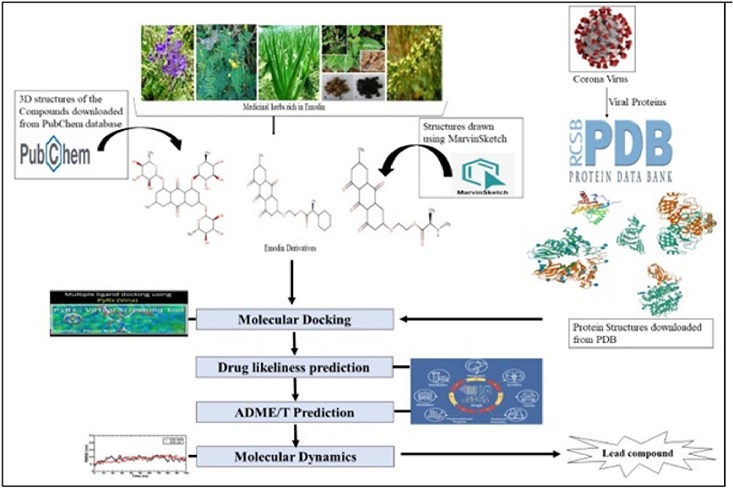Herbs and Phytochemicals: Emodin Derivatives as Potential Weapons Against SARS-CoV-2
Nikhil Prasad Fact checked by:Thailand Medical News Team Jun 01, 2024 10 months, 3 weeks, 4 days, 6 hours, 39 minutes ago
Herbs and Phytochemicals: The global pandemic caused by SARS-CoV-2 continues to challenge health systems worldwide, necessitating the development of new antiviral drugs. Despite the availability of vaccines, the high mutation rate of the virus means that effective medications are still in demand. Phytochemicals, known for their safety and efficacy, are being explored for their potential to combat various ailments, including COVID-19. This
Herbs and Phytochemicals delves into the promising role of emodin, a bioactive anthraquinone found in various herbs, and its derivatives in inhibiting key proteins of SARS-CoV-2.
 Graphical Abstract - Emodin Derivatives as Potential Weapons Against SARS-CoV-2
The SARS-CoV-2 Virus: A Closer Look
Graphical Abstract - Emodin Derivatives as Potential Weapons Against SARS-CoV-2
The SARS-CoV-2 Virus: A Closer Look
SARS-CoV-2, the virus responsible for COVID-19, is a single-stranded RNA virus. Its genome consists of two overlapping open reading frames (ORFs), which encode non-structural and structural proteins essential for viral replication and infection. Key proteins include the spike (S) protein, which facilitates viral entry into host cells, and proteases like 3CLpro and PLpro, which process viral polyproteins into functional units. Inhibiting these proteins can significantly reduce the virus's ability to replicate and spread.
Emodin and Its Derivatives: Nature's Answer to Viral Inhibition
Emodin (1,3,8-trihydroxy-6-methyl-anthracene-9,10-dione) is a bioactive compound found in various plants such as Cassia occidentalis, Aloe vera, and Polygonum cuspidatum. It exhibits a range of therapeutic properties, including antiviral activity. However, its clinical use is limited by poor water solubility and bioavailability. Researchers are now exploring emodin derivatives, which might overcome these limitations and offer potent antiviral effects against SARS-CoV-2.
In Silico Analysis: A Glimpse into the Future of Drug Discovery
Using advanced computational techniques, scientists have screened 110 emodin derivatives against key SARS-CoV-2 proteins, including hemagglutinin-esterase (HE), papain-like protease (PLpro), major protease (3CLpro), non-structural protein 3 (nsp3), and the spike protein. The study identified several promising compounds, namely ED21, ED25, ED5, and ED29, which exhibited strong binding affinities and inhibitory effects.
Molecular Docking: Identifying the Best Candidates
Molecular docking studies revealed that ED21, ED25, ED5, and ED29 could effectively bind to and inhibit their respective target proteins. For instance, ED21 showed the highest inhibition of HE, with significant hydrophobic interactions and hydrogen bonds. Similarly, ED25 and ED29 demonstrated strong binding to 3CLpro and PLpro, respectively, while ED5 effectively inhibited the spike protein.
Dynamic Simulations: Ensuring Stability and Effectiveness
Further dynamic simulations assessed the stability of these protein-ligand complexes over time. The results indicated that all complexes, including ED21-H
E, ED25-3CLpro, ED5-S, ED29-PLpro, and ED29-nsp3, remained stable with minimal deviations. This stability is crucial for the potential therapeutic effectiveness of these compounds.
Drug Likeliness and ADMET Analysis: Assessing the Therapeutic Potential
Drug likeliness, as per Lipinski’s rule of five, and ADMET (absorption, distribution, metabolism, excretion, and toxicity) analyses were conducted to evaluate the therapeutic potential of the identified compounds. ED21 and ED25 emerged as the most promising drug-like candidates, showing high therapeutic value and minimal side effects. They exhibited excellent human intestinal absorption (HIA) and moderate Madin-Darby canine kidney (MDCK) permeability, crucial for drug effectiveness.
Emodin's Multi-Target Approach Against SARS-CoV-2
The multifaceted approach of emodin and its derivatives in targeting multiple SARS-CoV-2 proteins makes them particularly promising. Their ability to inhibit both structural and non-structural proteins of the virus can potentially reduce viral replication and infection. Additionally, their minimal side effects and high therapeutic value enhance their candidacy as effective antiviral drugs.
Future Directions: Bridging In Silico and In Vivo Studies
While the in-silico findings are promising, further in vitro and in vivo studies are essential to validate the effectiveness of these emodin derivatives. The transition from computational predictions to practical applications will require comprehensive testing in biological systems. Nonetheless, this research marks a significant step forward in the quest for effective antiviral therapies, potentially offering new hope in the fight against COVID-19.
Conclusion: A Step Closer to Effective Antiviral Therapy
The study highlights the potential of emodin derivatives as effective inhibitors of SARS-CoV-2 proteins. Through in silico analyses, molecular docking, and dynamic simulations, ED21 and ED25 stood out as promising candidates with high stability and drug-like properties. These findings pave the way for further preclinical evaluations and the development of potent antiviral drugs to combat COVID-19.
The study findings were published in the peer reviewed journal: Kuwait Journal of Science
https://www.sciencedirect.com/science/article/pii/S2307410824000907
For the latest on
Herbs And Phytochemicals, keep on logging to Thailand Medical News.
Read Also:
https://www.thailandmedical.news/news/herbs-and-phytochemicals-in-vitro-and-silico-studies-shows-potential-of-olive-leaves-extract-as-an-antiviral-against-sars-cov-2
https://www.thailandmedical.news/news/herbs-and-phytochemicals-study-shows-that-zingerone-and-shogoal-from-ginger-can-inhibit-sars-cov-2
https://www.thailandmedical.news/news/herbs-and-phytochemicals-harringtonine-from-cephalotaxus-fortunei-inhibits-sars-cov-2-and-exhibits-excellent-lung-pharmacokinetic-properties
